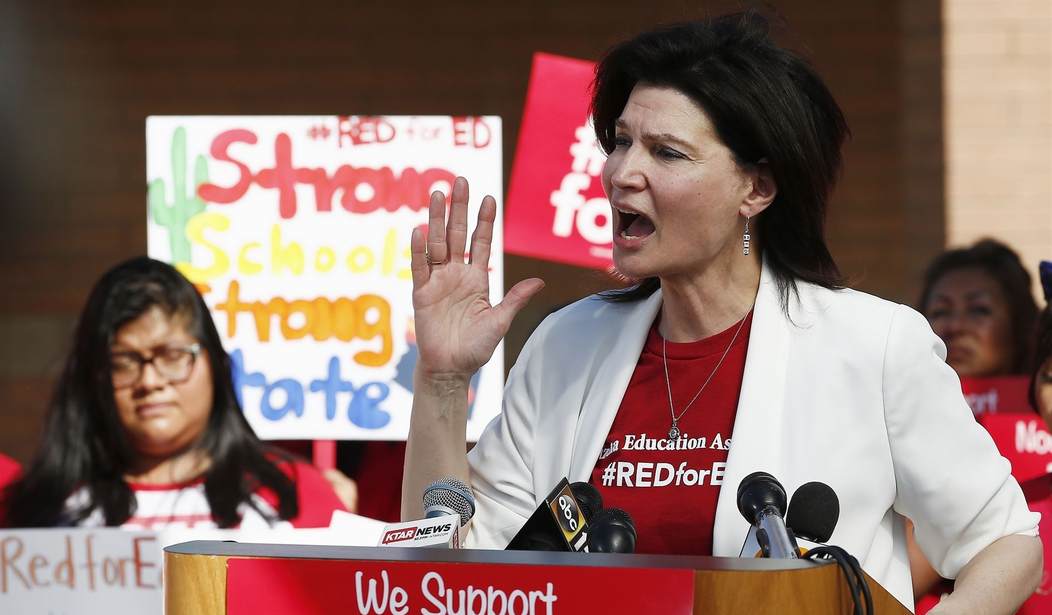Lily Eskelsen Garcia, the former teachers union boss who wants to be Joe Biden's education secretary, has been slammed for her disparaging comments about learning-disabled children. Garcia should meet Mia Giordano, a young woman who overcame her learning disabilities outside of the conventional public school system.
Garcia, who headed the National Education Association, referred to children with disabilities as "the chronically 'tarded' and medically annoying" in a speech a few years ago.
While Garcia apologized for her remarks, she did not apologize for the one-size-fits-all public school system, which she and the NEA so adamantly defend, but which fails to meet the needs of many children with learning disabilities.
In the public schools there is largely just one paradigm used to address the needs of children with learning disabilities.
Claire Goss was a longtime public-school education psychologist in the San Francisco Bay Area.
"What I wanted to do," said Goss, "was really help kids and families understand that we all learn differently and there are many, many different approaches that could be addressed, but in public education you have boxes you have to fit kids into."
What kind of boxes? The reigning learning-disability paradigm in public schools is based on compensatory strategies, which emphasize those functions where a child is strong and de-emphasize those that are weak.
"If you had an auditory issue," explained Goss, "they would emphasize the visual, so it's compensatory."
Implementing a successful alternative model to treat learning disabilities in the public schools would be impossible, noted Goss, because teacher training and funding are geared to one model.
Yet, the public schools' one-size-fits-all compensatory-strategies model does not work for all children.
Take Mia Giordano, for example. As a young girl, Mia, who is now eighteen, had a health issue that resulted in damage to her brain. As a result, she had serious learning disabilities, including having great difficulty speaking, reading, and writing.
Mia attended both conventional public and private schools, but she did not receive the type of instruction that addressed her brain-based learning issues.
Only after Mia's mom decided to homeschool her did her whole learning world change for the better.
Mia enrolled in a small private learning center that used the Arrowsmith Program, which identifies weak areas of the brain and uses various exercises to strengthen those areas so that the brain becomes a strong whole.
Mia was evaluated by Arrowsmith staff and was found to have severe problems in cognitive functions such as motor symbol sequencing, which prevents writing out the alphabet, and symbol relations, which makes it hard to read the hands of a clock.
To strengthen the weak areas of her brain, Mia would do repetitive exercises such as reading clock faces with up to ten hands, with each hand signifying increments of time from seconds to centuries.
"Deciphering the clock with speed and accuracy," said Mia, "helped my reasoning abilities, my reading comprehension, and my math problem solving."
Mia stayed in the Arrowsmith Program for four years, with the exercises changing and strengthening her brain, and her transformation was amazing. She went from having difficulty reading sentences to reading more than fifty books in the summer before she completed the program.
International research has shown that the Arrowsmith Program successfully improves academic skills and cognitive functions.
Yet, Claire Goss observed that Arrowsmith would be impossible to implement in the public schools because it does not fit the dominant paradigm.
For this reason, school-choice programs such as Florida's Gardiner Scholarship Program, which creates state-funded education savings accounts for parents to use to pay for educational services like Arrowsmith, should be enacted in all states in order to meet the individual needs of children with learning disabilities.
Lily Eskelsen Garcia used her union leadership post to advocate against more choice in education. However, it is that opportunity to choose more effective learning that has changed the lives of so many children. As Mia notes, "Only when all families have the same ability to make choices will all children have the chance to succeed that I had."
Lance Izumi is senior director of the Center for Education at the Pacific Research Institute. He is the co-author, with Mia Giordano, of the 2020 book A Kite in a Hurricane No More: The Journey of One Young Woman Who Overcame Learning Disabilities through Science and Educational Choice.
Would-be Education Secretary Lily Garcia Should Meet Mia Giordano
The opinions expressed by columnists are their own and do not necessarily represent the views of Townhall.com.

Advertisement
Recommended
Trending on Townhall Videos
Advertisement
Advertisement
Advertisement
























Join the conversation as a VIP Member